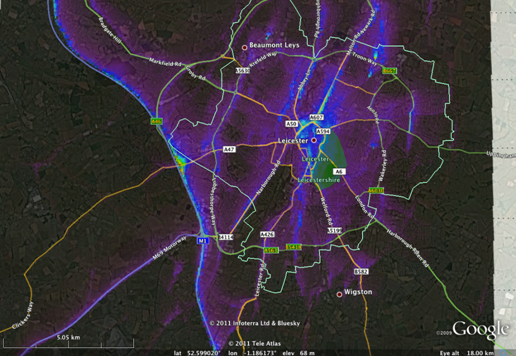
Objectives of the service
The overall objective of this study is to establish whether an integrated system of traffic and air quality management, strengthened through the use of GNSS, air quality and meteorology data from space-borne assets, could provide societal and economic benefits through implementation at the local authority level.
This feasibility study will define the requirements for an integrated traffic and air quality management system, which would use a selection of in-situ and satellite data to provide improved information and advice to local authorities. The study will establish user requirements and priorities and document state-of-the-art solutions. The proposed iTRAQ architecture will be tailored to meet user needs, and trialled in a region of interest within the city of Leicester to explore the potential benefits of system implementation. The project will also undertake an analysis of the economic and non-economic viability of the system, and will prepare a roadmap for further implementation of the system as a demonstration project.

Users and their needs
The target market is anticipated to be that of the local authorities of medium to large towns (typically >200,000 people). In the iTRAQ feasibility study the user is Leicester City Council in the UK, however surrounding local authorities that cover both nearby towns and the adjacent rural areas are being invited to oversee this project and encouraged to participate in the planned follow-on Demonstration Activity.
Service/ system concept
The service concept is to provide a core capability that can integrate with existing terrestrial data feeds and systems, and to provide instructions to the local traffic light control system such that the traffic flows around a city can be optimised. This leads to an integrated approach to traffic management and air quality across a city, whereas at present these issues may be managed separately.
It is acknowledged that different users will have different levels of maturity with respect to in situ systems, or may have chosen alternative providers than those chosen by Leicester City Council. Therefore the iTRAQ system anticipates using whatever data is available at any single user's location. The core of the system is a computational intelligence module that estimates the optimal solution, and this is also able to provide outputs for any other purposes that the users might need (e.g. statutory reporting)
Space Added Value
In iTRAQ, utilizing Earth Observation data provides added value for repeatedly updating air quality status information for wide areas, also acting as a baseline for the traffic and environmental control system. Additionally GNSS technologies are sourced for real-time update of traffic status. Whilst GNSS data feeds are still in their infancy in terms of the number of vehicles that are equipped to transmit their position (typically limited to local bus or taxi companies), the latest generation of smart devices will change the way that this sort of information is used and accessible.
Current Status
The Feasibility Study has been successfully completed, all meetings have taken place and all deliverables submitted. The Final Review meeting took place on 18 April 2012.
The Feasibility Study concluded that iTRAQ is technically and economically feasible and can provide improvements to both traffic and air quality which, in a full system implementation, is likely to meet the majority of local authority user needs. Simulations have shown that the recommendations made by iTRAQ for changes at traffic junctions led to an increase in traffic flow, which in turn effectively reduced the overall duration of the traffic peak and the duration of particular pollution peaks.
At this stage some elements of the system are not technically mature, therefore further development is required to take iTRAQ to a fully operational system. These developments would be addressed in a Demonstration Phase. A follow on piece of work called "iTRAQ-X" (a second implementation of iTRAQ, this time in Northamptonshire) is currently underway to resolve some of the technical issues highlighted in the Feasibility Study as well as to understand different user requirements. This piece of work is due to be completed Autumn 2012. A proposal for a Demonstration Project is planned to be submitted by 2013.
Prime Contractor(s)
Subcontractor(s)






